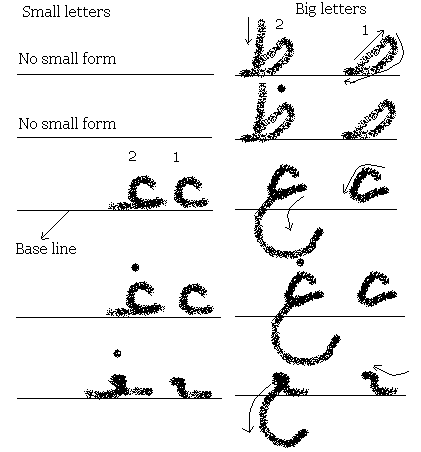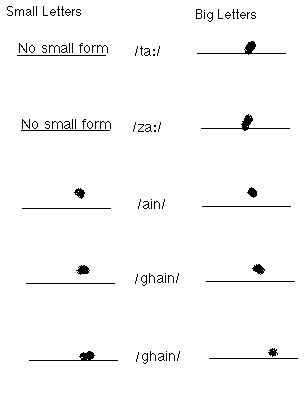
Persian Lesson 6 – Letters /ta:/ to /ghæin/
Persian Letters /ta:/ to /ghæin/
Hello everyone, welcome back!
Today, we are going to learn Persian letters /ta:/ to /ghæin/. How do you find the lessons? Is it really helping? I hope it is. I’ll be grateful if you let me know how the site is doing. Please keep on writing.
All right. To begin with, let’s take a look at the letters we learned last week. Remember? Good! Now repeat them again. They are ![]() ,
, ![]() ,
, ![]() ,
, ![]() ,
, ![]() . Click here if you need to listen again.
. Click here if you need to listen again.
Ok. Now let’s start the new lesson. As you know, so far we have studied 18 letters and practiced them well with the help of short and long vowels. As I have told you before, you shouldn’t skip any of the lessons and at the same time you have to learn how to write and detect the letters. It will help you get strong with the basics. You are quite aware that it’s you who have chosen this site to learn Persian. And you know that you are doing this because of the reasons you have in learning this language. As a result, I don’t need to remind you on and on to follow the instructions as you are being told. All I must do is try hard, as much as I can, to provide you with the good, easy, and reasonable way to help you learn this language. In response, all you have to do is follow the instructions and practice as much as you need. I’ll be really happy just when I see your progress. Is that fair enough?!
Today’s letters,

This letter has only one form. When combined with the vowels, it may be pronounced as ![]() . Need help? Here!
. Need help? Here!
Note: as you see, these two letters, ![]() and
and ![]() , when combined with the vowels, have the same pronunciation. And of course, they have different functions.
, when combined with the vowels, have the same pronunciation. And of course, they have different functions.
This letter has only one form. By one form, I mean they have no distinguishable big and small forms. When combined, it may be pronounced as ![]() .
.
Note: as you see, these letters, ![]() ,
, ![]() ,
, ![]() , and
, and ![]() , when combined, have the same pronunciations but different functions. Currently, you don’t need to worry at all about these functions. Later you will see that it will not be really confusing. Just learn the letters as you are being told. That’s all.
, when combined, have the same pronunciations but different functions. Currently, you don’t need to worry at all about these functions. Later you will see that it will not be really confusing. Just learn the letters as you are being told. That’s all.
21. ![]() This is the big letter. I need to explain some about the way it is pronounced. I am sure all of you know the pronunciation of this English word: Main /mein/. Is that correct? Ok. Now, just suppose that we pronounce it this way: /mæin/. And you know /æ/as /æ/ in dad. Now what will happen if we delete ‘m’ from its pronunciation? It’s quite clear. We will have /æin/instead of /mæin/. So, this letter is called /æin/.
This is the big letter. I need to explain some about the way it is pronounced. I am sure all of you know the pronunciation of this English word: Main /mein/. Is that correct? Ok. Now, just suppose that we pronounce it this way: /mæin/. And you know /æ/as /æ/ in dad. Now what will happen if we delete ‘m’ from its pronunciation? It’s quite clear. We will have /æin/instead of /mæin/. So, this letter is called /æin/.
It appears at the end of the words and stands separately. Like this word: ![]() .
.
Sometimes, it appears at the end of the letters but it is attached to the previous letter. In this case, it will be written as ![]() . Like this word:
. Like this word:![]() .
.
![]() This is the small letter /æin/. It comes at the beginning of the words and is attached to the letters that come after it. Like this word:
This is the small letter /æin/. It comes at the beginning of the words and is attached to the letters that come after it. Like this word: ![]() .
.
![]() This one is the small form of the same letter too. The difference is that this small form sits between two letters and is attached to them. Like this word:
This one is the small form of the same letter too. The difference is that this small form sits between two letters and is attached to them. Like this word: ![]() . It does not appear at the beginning or end of the words.
. It does not appear at the beginning or end of the words.
In short, this is ![]() /æin/, and has four different forms.
/æin/, and has four different forms.
When combined, it may be pronounced as ![]() . Click here to listen.
. Click here to listen.
Note: as you see, these two letters, ![]() and
and ![]() , when combined, have the same pronunciation but different functions.
, when combined, have the same pronunciation but different functions.
22. ![]() This is the big letter. Like the previous one, it has four forms. The way it is pronounced needs some explanations. However, if you think the explanations of the letters are not convincing, simply listen to their pronunciations.
This is the big letter. Like the previous one, it has four forms. The way it is pronounced needs some explanations. However, if you think the explanations of the letters are not convincing, simply listen to their pronunciations.
Hopefully, all of you know the pronunciation of ‘r’ in French words like ‘bonjour‘. The pronunciation of this letter in Persian is represented by /gh/, in Latin-based writings. As you saw in number 21, we changed the pronunciation of this English word ‘Main’ into /æin/. Now, simply put the French letter ‘r’ or its Persian Latin-based equivalent /gh/ at the beginning of /æin/. We will have /ræin/ or /ghæin/. Is that clear? So, this letter is called /ghæin/.
It stands separately at the end of the words, like what you see in this word: ![]() .
.
Note: At this stage, you don’t need to know these words and it’s quite natural. All you need to know is the letters that you are just learning. I show these letters in different words to just let you see the status of these letters in different words. That’s all.
![]() This is also the big form of the same letter and comes at the end of the words. The difference is that
This is also the big form of the same letter and comes at the end of the words. The difference is that ![]() is attached to the previous letters. Like this word:
is attached to the previous letters. Like this word: ![]() .
.
![]() This is the small letter. It comes at the beginning of the words and is attached to the letters that come after it. Like this word:
This is the small letter. It comes at the beginning of the words and is attached to the letters that come after it. Like this word: ![]() .
.
![]() This is the small letter too. But it appears between two letters and is attached to both of them. Like here:
This is the small letter too. But it appears between two letters and is attached to both of them. Like here: ![]() .
.
This letter, when combined with the vowels, is pronounced as ![]() .
.

If you need to listen to today’s letters once more, click here.
All right. With this, we come to the end of lesson 6. I hope you are enjoying these lessons. As you know, practice makes perfect!






Leave a Reply
Your email address will not be published. Required fields are marked *
All Comments (0)